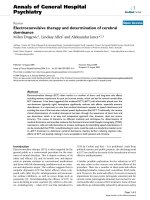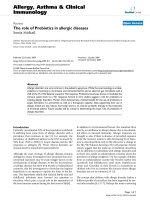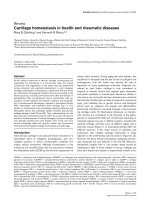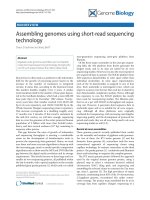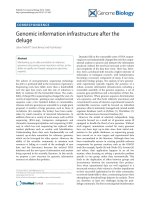Báo cáo y học: "Tremendous bleeding complication after vacuumassisted sternal closure" pptx
Bạn đang xem bản rút gọn của tài liệu. Xem và tải ngay bản đầy đủ của tài liệu tại đây (383.51 KB, 3 trang )
CAS E REP O R T Open Access
Tremendous bleeding complication after vacuum-
assisted sternal closure
Arndt H Kiessling
1*
, Andreas Lehmann
3
, Frank Isgro
2
, Anton Moritz
1
Abstract
Vacuum-assisted closure (VAC) of complex infected wounds has recently gained popularity among various surgical
specialties. The system is based on the application of negative pressure by controlled suction to the wound
surface. The effectiven ess of the VAC System on microcirculation and the promotion of granulation tissue
proliferation are proved. No contraindications for the use in deep sternal wounds in cardiac surgery are described.
In our case report we illustrate a scenario were a patient developed severe bleeding from the ascending aorta by
penetration of wire fragments in the vessel. We conclude that all free particles in the sternum have to be removed
completely before negative pressure is used.
Background
Sternal wound heali ng disorders, with an incidence of 1
to 5%, are a frequent and serious complication following
cardio-surgical operations [1].
Vacuum sealing t reatment (VST) now represents an
established procedure for the care o f sternal infections
[2] and is used by a majority of cardiac surgical centres
in the Federal Republic of Germany for the management
of deep, post-sternotomy wounds [1].
Uniform treatme nt guidelines have not been published
thus far. This also applies to contraindications for the
use of vacuum sealing treatment in cardiac surgery.
Until now, the contraindications have been documented
in general surgery and dermatology and focus on the
direct effect of suction upon exposed blood vessels [3].
The following case report i s intended to point out a
possible contrai ndication from the field of cardiac
surgery.
Case presentation
A 68 year old patient attended our outpatient depart-
ment in October 2009 to undergo an elective coronary
aortic bypass graft (CABG). The patient had triple-vessel
coronary artery disease with good systolic left ventricu-
lar function (LVEF 58%). Myocardial infarction was not
reported. Lately, however, angina complaints occurred at
rest. Aside from obesity (BMI 32 kg/m
2
), the risk profile
included hyperlipidaemia, non-insulin-dependent dia-
betes mellitus type II and nicotine abuse of 20 pack/
year. Hysterectomy and appendectomy were the only
prior operations. The surgical risk was assessed with a
EuroSCORE value of 6 and an A SA score of 3. The
logistic EuroSCORE calculated a perioperative mortality
of 5.8%.
During the uncomplicated elective surgery, the left
internal thoracic artery (target vessel was the LAD) and
two great saphenous vein segments were anastomosed
with the target vessels, marginal branch 1 of the RCX
and RCA. (perfusion time 41 min., aortic clamp time
29 min.). The full sternotomy was closed with 3 single
wires in the manubrium and 3 figure-of-eight wires in
the body of t he sternum. The patient was transferred to
the intensive care unit intubated and in stable cardiovas-
cular condition. Further progress was uncomplicated.
Three-day perioperative antibiotic prophylaxis was car-
ried out with 1.5 g cefuroxime t.i.d. The patient was
transferred to an external rehabilitation facility on post-
operative day (POD) 12 with a largely un-inflamed
wound. The wound margins appeared reddened, but the
skin was approx imated throughou t its length. (Body
temperature 37.3°, leucocyte count 8.9/nL)
The patient was readmitted on POD 19 due to wound
dehiscence at the junction of the distal and middle
thirds. Non-multi-resistant Staphylococcus epidermidis
was microbiologically confirmed. The wire cerclages
were intact. After preliminary local wound debridement
* Correspondence:
1
Department of Thoracic and Cardiovascular Surgery, Johann Wolfgang
Goethe University, Frankfurt am Main, Germany
Full list of author information is available at the end of the article
Kiessling et al. Journal of Cardiothoracic Surgery 2011, 6:16
/>© 2011 Kiessling et al; licensee BioMed Central Ltd. This is an Open Access article distributed under the terms of the Creative
Commons Attribution License ( nses/by/2.0), which permits unrestricted use, distribu tion, and
reproduction in any medium, provided the original work is properly cited.
and daily irrigation, surgical wound revision was
planned for POD 23 d ue to increasing putrid secretion.
Appropriate antibiotic treatment was started prior to
surgery with linezolid 600 mg b.i.d. At operation, the
sternum still did not sh ow any dehiscence, the cerclages
were sound, and t he sternum was not fractured. The
wound was managed with bilateral pectoralis muscle
flaps, and wound drains were inserted for a period of
seven days.
The patient was mobilised on the ward. From POD
40, the skin incision, which was initially closed with
interrupted sutures, showed increased erythema, secre-
tion and failing approximation. After removal of the
non-absorbable subcutaneous sutures, the medial sternal
defect was managed under aseptic conditions with
vacuum-assisted suction. The sponge size was about 12
× 7 cm. Suction was set at a continuous -125 mmHg.
At the previously performed debridement, there were
loose wires and several rather large bone fragments,
which were still held in place with wires. The wires
were still intact on the (AP) chest x-ray.
The patient tolerated the treatment well and still
remained mobile. Due to her smoking habits, she suffered
repeated intense coughing fits while in hospital. As a
result, the sponge was changed every three days. Another
radiograph was not taken. On POD 51, the patient suf-
fered circulatory depression during the night. The resusci-
tation team found the patient still responsive in fulminant,
hypovolaemic circulatory shock. T here were large
amounts of blood clots underneath the bulging sternal
dressing. Upon removal, there was a spurting haemorrhage
in the area of the ascending aorta. Bleeding was stopped
by digital compression; the patient was anaesthetised and
transferred to surgery under emergency conditions. There
were numerous sternal and wire fragments. There was an
identifiable bleeding point on the ascending aorta, wh ich
was managed with felt sutures. The probable cause of the
haemorrhage was penetration by wire fragments during
vacuum treatment. The wire fragments had become mobi-
lised, due to the suction effect.
Repeat osteosynthesis and complete debridement of all
fragmen ts ensued. The wound was now closed primarily
with interrupted sutures. Further v acuum-a ssisted clo-
sure was not used. Linezolid was given without a micro-
biological confirmation.
The patient was again transferred to the intensive care
unit and recovered from the massive transfusion. The
ventilation time was 51 hours; she was discharged o n
POD 72, subjectively well, for further rehabilitation
measures.
Discussion
Sternal wound healing complications are frequently trea-
ted by vacuum-assisted closure following surgical
debridement [4] This method offers great advantages
compared with earlier forms of treating wounds. Better
breathing conditions are ens ured for the patient by sta-
bilising the two halves of the sternum; granulation is
promoted, and t he wound environment is improved by
aspiration of secretion [5-7].
Vacuum-assisted treatment has, to a large extent,
become the standard pro cedure for treating postopera-
tive wound infections in cardiac surgery [8]. Dehisced
sternal w ounds are complex, involve major organs and
complications can be life-threatening [9].
There are, however, still no authoritative data and stu-
dies available on the suction mode and i ntensity. Simi-
larly, only very few contraindications for the use of
vacuum treatment have been published so far. The Ger-
man Wound Healing Society (DGfW) formulated the
following contraindications in 2003 [10]:
▪ coagulation disorders
▪ exposed blood vessels
▪ necrotic wound margin
▪ untreated osteomyelitis
▪ neoplastic wounds
We would like to submit another contraindication,
based on the case described above, and draw attention
to loose fragments of the sternum and wire. These
pieces can be mobilised in the thorax and, as in the
reported case, cause a serious complication when it
penetrates blood vessels or the ventricles.
Conclusion
If vacuum sealing treatment is used, close radiological
monitoring and examinations are indicated when chan-
ging the sponge, and all loose fragments must be
removed without compromise.
Consent
Written informed consent was obtained from the patient
for publication of this case report. A copy of the written
consent is available for review by the Editor-in-Chief of
this journal.
Author details
1
Department of Thoracic and Cardiovascular Surgery, Johann Wolfgang
Goethe University, Fran kfurt am Main, Germany.
2
Department of Cardiac
Surgery, Klinikum Ludwigshafen, 67069 Ludwigshafen, Germany.
3
Anaesthesiology and Operative Intensive Care, Klinikum Ludwigshafen,
67069 Ludwigshafen, Germany.
Authors’ contributions
AHK drafted the manuscript and was part of the surgical resuscitation team.
AL was part of the anaesthesiologist rescue team. FI was part of the surgical
team and reviewed the case report. AM reviewed the case report. All
authors read and approved the final manuscript.
Declaration of competing interests
The authors declare that they have no competing interests.
Kiessling et al. Journal of Cardiothoracic Surgery 2011, 6 :16
/>Page 2 of 3
Received: 13 October 2010 Accepted: 9 February 2011
Published: 9 February 2011
References
1. Schimmer C, Sommer SP, Bensch M, Leyh R: Primary treatment of deep
sternal wound infection after cardiac surgery: a survey of German heart
surgery centers. Interact Cardiovasc Thorac Surg 2007, 6:708-11.
2. Reiss N, Schuett U, Kemper M, Bairaktaris A, Koerfer R: New method for
sternal closure after vacuum-assisted therapy in deep sternal infections
after cardiac surgery. Ann Thorac Surg 2007, 83:2246-7.
3. White RA, Miki RA, Kazmier P, Anglen JO: Vacuum-assisted closure
complicated by erosion and hemorrhage of the anterior tibial artery.
J Orthop Trauma 2005, 19:56-9.
4. `Schimmer C, Sommer SP, Bensch M, Elert O, Leyh R: Management of
poststernotomy mediastinitis: experience and results of different
therapy modalities. Thorac Cardiovasc Surg 2008, 56:200-4.
5. Doss M, Martens S, Wood JP, Wolff JD, Baier C, Moritz A: Vacuum-assisted
suction drainage versus conventional treatment in the management of
poststernotomy osteomyelitis. Eur J Cardiothorac Surg 2002, 22:934-8.
6. Graf K, Ott E, Vonberg RP, Kuehn C, Haverich A, Chaberny IF: Economic
aspects of deep sternal wound infections. Eur J Cardiothorac Surg 2010,
37(4):893-6.
7. Malmsjö M, Ingemansson R, Sjögren J: Mechanisms governing the effects
of vacuum-assisted closure in cardiac surgery. Plast Reconstr Surg 2007,
120:1266-75.
8. Strecker T, Rösch J, Horch RE, Weyand M, Kneser U: Sternal wound
infections following cardiac surgery: risk factor analysis and
interdisciplinary treatment. Heart Surg Forum 2007, 10:E366-71.
9. Grauhan O, Navarsadyan A, Hussmann J, Hetzer R: Infectious erosion of
aorta ascendens during vacuum-assisted therapy of mediastinitis.
Interact Cardiovasc Thorac Surg 2010, 11(4):493-4.
10. Wild T, Wetzel-Roth W, Zöch G, German and Austrian Societies for Wound
Healing and Wound Management: Consensus of the German and
Austrian Societies for Wound Healing and Wound Management on
vacuum closure and the V.A.C. treatment unit. Zentralbl Chir 2004,
129(Suppl 1):S7-11.
doi:10.1186/1749-8090-6-16
Cite this article as: Kiessling et al.: Tremendous bleeding complication
after vacuum-assisted sternal closure. Journal of Cardiothoracic Surgery
2011 6:16.
Submit your next manuscript to BioMed Central
and take full advantage of:
• Convenient online submission
• Thorough peer review
• No space constraints or color figure charges
• Immediate publication on acceptance
• Inclusion in PubMed, CAS, Scopus and Google Scholar
• Research which is freely available for redistribution
Submit your manuscript at
www.biomedcentral.com/submit
Kiessling et al. Journal of Cardiothoracic Surgery 2011, 6 :16
/>Page 3 of 3
